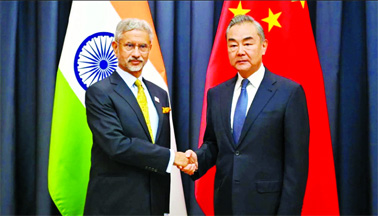
New Felhi (TIP)- External affairs minister S Jaishankar and his Chinese counterpart Wang Yi on Friday, Feb 21, discussed ways to further normalise bilateral ties, such as resumption of the Kailash Mansarovar pilgrimage and direct flights between the two countries, following up on an understanding last year to end the face-off on the Line of Actual Control (LAC).
The two foreign ministers met on the sidelines of the G20 foreign ministers’ meeting in Johannesburg, South Africa – the latest in a string of meetings between top leaders of India and China since the two sides agreed on October 21 to disengage frontline forces at the two “friction points” of Demchok and Depsang in Ladakh sector of LAC.
Jaishankar and Wang “reviewed developments in our bilateral relationship since their last meeting in November”, external affairs ministry spokesperson Randhir Jaiswal told a regular media briefing.
Among the issues that figured during the meeting that lasted about 30 minutes were management of peace and tranquillity in the border areas, the resumption of the Kailash Mansarovar Yatra, trans-border rivers, flight connectivity and travel facilitation, Jaiswal said. The two leaders also exchanged views on the G20 and the Shanghai Cooperation Organisation (SCO).
While China has pushed for the resumption of direct flights, which were suspended in 2020, and enhancement of trade relations, India has been insisting on the resumption of the Kailash Mansarovar pilgrimage from this spring. New Delhi has also expressed concern about Beijing’s plan to build the world’s largest hydropower project on Yarlung Tsangpo river in Tibet, which will have significant ramifications for India and Bangladesh, and called for transparency and consultations with downstream countries.
This was also the second meeting between the two foreign ministers since the two countries began the process of normalising their relations, which had plummeted to a six-decade low because of the four-year-long military standoff in Ladakh sector of the LAC. The face-off was triggered by China’s massing of troops on the disputed frontier in violation of existing border management agreements.
The tensions on the LAC were exacerbated by a brutal clash in Galwan Valley in June 2020 that killed 20 Indian soldiers and an unspecified number of Chinese troops – the first casualties on the disputed border in 45 years. Indian banned dozens of Chinese apps and effectively restricted investments by Chinese firms.
The two sides then held dozens of rounds of talks through diplomatic and military channels that led to the withdrawal of frontline forces on both banks of Pangong Lake, Gogra and Hot Springs. However, China’s insistence that the border issue should be separated from progress in the overall relationship stymied further progress in the talks till the breakthrough last October.





Be the first to comment